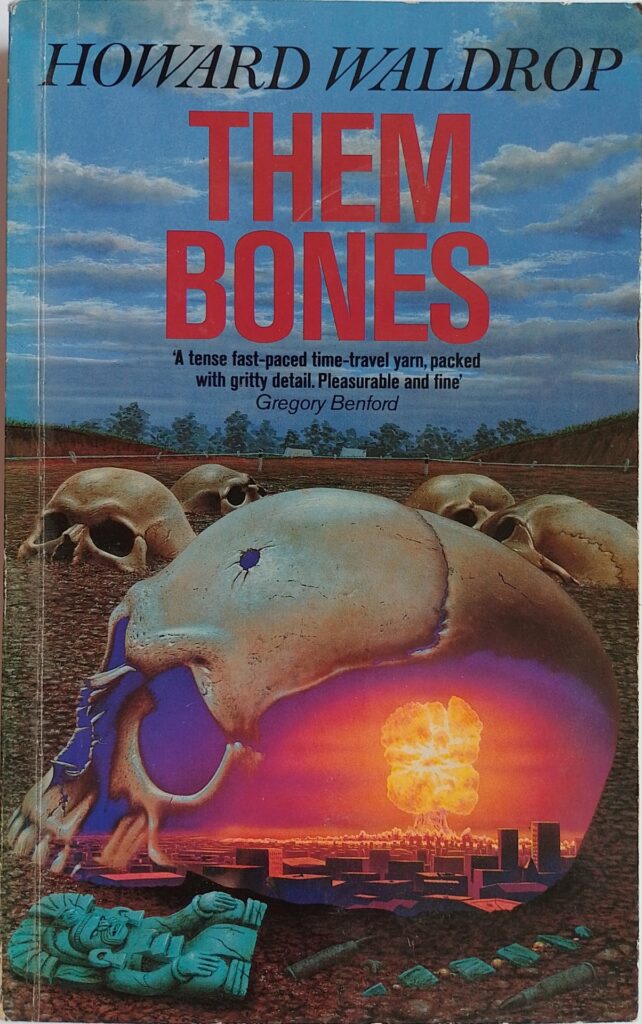First published 1989. Legend paperback, 1989, pp 218, c.60,000 words.
This is a science fiction book set in the past. It is structured as three interleaving story strands, one of which concerns a group of archaeologists who are digging in some strange burial mounds in Louisiana in 1929, the second is the story of a time traveller arrived from the near future in what he hoped would be 1930s Louisiana to prepare for the arrival of a larger group from the future whose mission is to change the course of history to prevent the man-made catastrophe that has overtaken their world. The third strand concerns the fate of that larger group of time travellers. Something went wrong with the time traveller machine and it has sent the people back what appears to be a much earlier time, perhaps the sixteenth century, only it’s not quite right. While time travelling devices going wrong is hardly an original device, it does provide fertile ground for the sort of good story we get here.
The archaeologists are doing an urgent project in an area scheduled to be flooded when dams are closed to control water levels around the Mississippi river. It should have been routine work because the burial mounds were a well-researched feature of that area. Then they uncover something that shouldn’t, couldn’t be there: items found in the mounds from a much later period. Is it a hoax? This could be a career defining moment for those involved: reputations could be made or ruined.
Leake is the protagonist of the second, principle, element, and he realises immediately that something is not right about his arrival in the past. We as readers are also made aware that something else is off – we are told that half of Louisiana had been wiped out in an explosion during World War 2. Leake has to learn to survive on his own by befriending the local people. There are some powerful evocations of what appears to be pre-conquest native North American people and animals. Yet we keep getting told about things that don’t accord with what we know about the period. The world is out of kilter.
The third element is told in the form of a diary by Smith, a female junior officer in the main party. This group is organised like a military operation and it too realises it has not been sent back to the time expected. They will be unable to complete their mission of changing history because they have arrived much too early. Initially they befriend the indigenous people, but these quickly become hostile. ‘primitive doesn’t mean stupid’ [p123] says one of the officers as the locals’ attacks prove effective.
While being distracting, the three elements of the story effectively converge by the end. It is hard to know if Waldrop is an optimist or a pessimist: In any universe, or alt-history, humans are bent on killing each other, and yet the actions of those flailing around trying to improve matters, seemingly making things worse, may in the end have the positive consequence they are seeking, although that is not worked out.
There are some scenes of great brutality depicted here for which the reader needs a strong stomach. These may well reflect accurately the horrific nature of tribal rivalry in the pre-conquest Americas. The European arrivals were no better or worse than the indigenous rulers.
There are a number of expressions used that were unfamiliar, but likely to be familiar to Louisianans, such as ‘gleepers’ [p10], ‘a boar shoat’ [p27], ‘matutinal’ [p80], ‘whippoorwill’ [p90], ‘Louisville slugger’ [p103], ‘Currier and Ives print “Waiting on the Levee”’ [p113]. All these can be guessed at from the context.
Waldrop has an easily read style. The subtlety comes in the out-of-kilter history that he sneaks in, surprisingly plausibly. Is the past we know the only possible one? Like all time-traveller books it also raises the question of what are the consequences of altering the past? He can also entertain: after one particularly brutal battle the section ends with: ‘Otherwise it was a beautiful spring morning.’ [p190]
Wikipedia biography of Waldrop: https://en.wikipedia.org/wiki/Howard_Waldrop
Wikipedia summary of the book: https://en.wikipedia.org/wiki/Them_Bones_(novel)
Others’ reviews of the book: https://www.goodreads.com/book/show/40957769-them-bones?ref=nav_sb_ss_3_10
© William John Graham, July 2023

